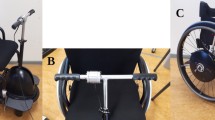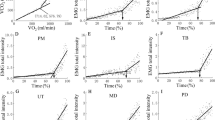Summary
To study the effect of different cycle frequencies on cardio-respiratory responses and propulsion technique in hand-rim wheelchair propulsion, experienced wheelchair sportsmen (WS group; n=6) and non-wheel chair users (NW group; n=6) performed wheelchair exercise tests on a motor-driven treadmill. The WS group wheeled at velocities of 0.55, 0.83, 1.11 and 1.39 m · s−1 and a slope of 2°. The NW group wheeled at 0.83, 1.11 and 1.39 m · s−1 and a 1° slope. In each test, a 3-min period at a freely chosen cycle frequency (FCF: 100%) was followed by four 3-min blocks of paced cycle frequencies at 60%, 80%, 120% and 140% FCF. Effects of both cycle frequency and velocity on physiological and propulsion technique parameters were studied.
Analysis of variance showed a significant effect (p<0.05) of cycle frequency on oxygen cost and gross mechanical efficiency in both the WS and NW group. This indicated the existence of an optimum cycle frequency which is close to the FCF at any given velocity. The optimum cycle frequency increased with velocity from 0.67 to 1.03 cps over the range studied (p< 0.05). Oxygen cost was ∼10% less at 100% FCF than at 60% or 140% FCF. Gross mechanical efficiency for the WS group at 100% FCF was 8.5%, 9.7%, 10.4% and 10.1%, respectively, at the four velocities. The similarity in the trend of oxygen cost and gross mechanical efficiency data in both the WS and NW groups suggests that an optimum cycle frequency is not merely a consequence of practice alone, but also reflects a physiologically determined optimum, dependent on muscle mechanics, e.g. velocity of contraction and power output of the muscles used.
Similar content being viewed by others
References
Boening D, Goenen Y, Maassen N (1984) Relationship between work load, pedal frequency and physical fitness. Int J Sports Med 5:92–97
Cerquiglini S, Figura F, Marchetti M, Ricci B (1981) Biomechanics of wheelchair propulsion. In: Morecki A, Kedzior K, Fidelius K, Wit A (eds) Biomechanics, vol VIIa. University Park Press, Baltimore, pp 410–419
Coast JR, Cox RH, Welch HG (1986) Optical pedalling rate in prolonged bouts of cycle ergometry. Med Sci Sports Exerc 18:225–230
Corlett EN, Mahadeva KA (1970) Relationship between freely choosen working pace and energy consumption curves. Ergonomics 13:517–524
Croissant PT, Boileau RA (1984) Effect of pedal rate, brake load and power on metabolic responses to bicycle ergometer work. Ergonomics 27:691–700
Davies CTM, Sargeant AJ (1974) Physiological responses to standardized arm work. Ergonomics 17:41–49
Haburn KL, Spaulding SJ (1986) Muscle activity in the spinal cord-injured during wheelchair ambulation. Am J Occup Ther 40:629–636
Hasse A (1932) Beitrag zur Ermittlung der günstigen Arbeitsbedingungen an einer Handkurbel. Arbeitsphysiologie 5:203–225
Lees A (1987) The effect of speed and load on the pushing technique used by racing wheelchair athletes. Biomechanics XI: Proceedings of XIth International Congress on Biomechanics. Free University Press, Amsterdam, 187 (Abstr)
Lesser W (1986) Ergonomische Untersuchung der Gestaltung antriebsrelevanter Einflussgrössen beim Rollstuhl mit Handantrieb. Fortschritt Berichte der VDI Zeitschriften, Reihe 17, nr. 28: Biotechnik. VDI-Verlag, Düsseldorf, pp 265
Loellgen H (1983) Zur Bedeutung der Tretgeschwindigkeit in der Ergometrie. In: Mellerowicz H, Franz IW (eds) Standardisierung, Kalibrierung und Methodik in der Ergometrie. Perimed, Erlangen, pp 46–54
Molen NH, Rozendal RH, Boon W (1972) Graphic representation of the relationship between oxygen-consumption and characteristics of normal gait of the human male. Proc Ned Akad Wet Ser C Biol Med Sci 75
Müller EA (1930) Die energetischen Bedingungen der senkrecht-abwärts gerichteten Zugbewegung. Arbeitsphysiologie 3:477–514
Powers SK, Beadle RE, Mangum M (1984) Exercise during arm ergometry: effects of speed and work rate. J Appl Phys Respir Environ Exerc Physiol 56:495–499
Salvendy G, Pilitsis J (1977) Psychophysiological aspects of paced and unpaced performance as influenced by age. Ergonomics 14:703–711
Sanderson DJ, Sommer HJ III (1985) Kinematic features of wheelchair propulsion. J Biomech 18:423–429
Seabury JJ, Adams WC, Ramey MR (1977) Influence of pedalling rate and power output on energy expenditure during bicycle ergometry. Ergonomics 20:491–498
Veeger HEJ, Woude LHV van der, Rozendal RH (1988) Wheelchair hand rim diameter, physiology and stroke technique. Biomechanics XI A, XIth International Congress on Biomechanics. International series on Biomechanics 7-A, Free University Press, Amsterdam, pp 519–523
Walsh CM, Marchiori GE, Steadward RD (1986) Effect of seat position on maximal linear velocity in wheelchair sprinting. Can J Appl Sport Sci 11:186–190
Woude LHV van der, Groot G de, Hollander AP, Ingen Schenau HJ van, Rozendal RH (1986) Wheelchair ergonomics and physiological testing of prototypes. Ergonomics 29:1561–1573
Woude LHV van der, Veeger HEJ, Rozendal RH (1987) Speed regulation in hand rim wheelchair propulsion. In: Steele RD, Gerrey W (eds) Proceedings of the Xth Annual Conference on Rehabilitation Technology. Available from RESNA, Washington DC: pp 483–486
Woude LHV van der, Veeger HEJ, Hendrich KM, Rozendal RH, Ingen Schenau GJ van (1988a) Manual wheelchair propulsion: effect of power output on physiology and technique. Med Sci Sports Exerc 20:70–78
Woude LHV van der, Veeger HEJ, Rozendal RH (1988b) Ergonomics of manual wheelchair propulsion. In: Bougie T, Davies A (eds) Wheelchairs: research, evaluation and information. COMAC-BME. Available from Commission of the European Communities, Milano, pp 101–112
Woude LHV van der, Veeger HEJ, Rozendal RH (1989) Propulsion technique in hand rim wheelchair ambulation. J Med Eng Technol (in press)
Zarrugh MY, Todd FN, Ralston HJ (1974) Optimization of energy expenditure during level walking. Eur J Appl Physiol 33:293–306
Author information
Authors and Affiliations
Rights and permissions
About this article
Cite this article
van der Woude, L.H.V., Veeger, H.E.J., Rozendal, R.H. et al. Optimum cycle frequencies in hand-rim wheelchair propulsion. Europ. J. Appl. Physiol. 58, 625–632 (1989). https://doi.org/10.1007/BF00418509
Accepted:
Issue Date:
DOI: https://doi.org/10.1007/BF00418509




